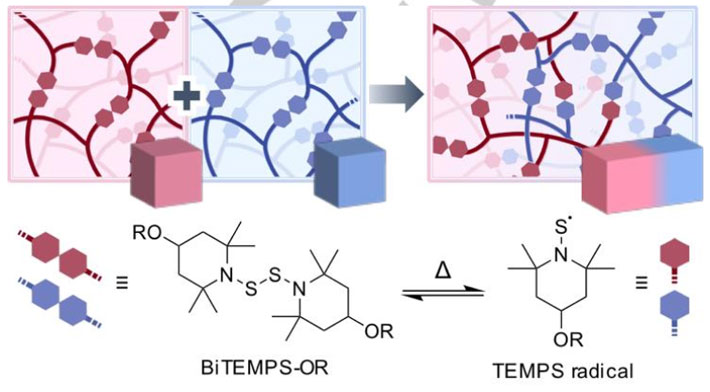Jan 22 2020
Cross-linked polymers can be described as structures in which huge molecular chains are joined together, providing excellent chemical resistance and mechanical properties to the end product. But it is not easy to modify these polymers.
 Cross-linking of different polymers. The proposed BiTEMPS linkers become cleaved at the S–S covalent bond at >80 °C. After cooling, the TEMPS radicals join once again, allowing for the fusion of different cross-linked polymers. Image Credit: Angewandte Chemie.
Cross-linking of different polymers. The proposed BiTEMPS linkers become cleaved at the S–S covalent bond at >80 °C. After cooling, the TEMPS radicals join once again, allowing for the fusion of different cross-linked polymers. Image Credit: Angewandte Chemie.
At the Tokyo Institute of Technology (Tokyo Tech), researchers have now developed a new technique through which different polymers can be easily fused together. This, in turn, helps to accurately adjust the end material’s properties, by choosing suitable base polymers and combining them at the optimal proportion.
Polymers can be defined as huge molecular chains made up of tiny repeating subunits. They occur all around the environment and can be found within humans.
A few known natural polymers are proteins and DNA. On the other hand, plastics and other similar synthetic polymers were initially created about 100 years ago. Since that time, synthetic polymers are being used by people in their day-to-day life due to their remarkable characteristics.
It is possible to customize the polymers based on their constituent subunits to impart them with several preferred properties such as permeability, stretchability, mechanical strength, etc.
Cross-linking the polymers is another method to obtain polymers that have more improved functionalities. Cross-linked polymers (CPLs) can be described as polymers that are fused together through unique cross-linker molecules.
Specific CPLs have interlocked tridimensional structures and hence exhibit excellent properties. Inspired by the promising applications of CPLs, a team of researchers from Tokyo Tech has now made a major breakthrough in this field: With the help of an unparalleled technique, the researchers have successfully cross-linked different types of CPLs together. The researchers were headed by Professor Hideyuki Otsuka.
The development of a novel method to fuse different CPLs would bring a revolution in the field, as their mechanical properties can be easily and systematically tuned in an operationally simple process.
Hideyuki Otsuka, Professor, Tokyo Institute of Technology
The scientists achieved this breakthrough by swapping things up in the cross-linker molecule used by them. A CPL with self-healing capabilities is extremely useful for a number of applications. To realize such a CPL, the polymers need to be fused by the so-called dynamic covalent bonds.
These covalent bonds also make it possible to link different types of CPLs together. However, the carbon molecules employed in linkers, which are presently available, are sensitive to oxidization. This makes it difficult to fuse and process the CPLs in large quantities.
To overcome this challenge, the researchers used a linker molecule, referred to as BiTEMPS. This linker molecule cross-links the polymers via a central sulfur–sulfur (S–S) covalent bond, which can be momentarily cleaved in half at greater than 80 °C temperatures. This promotes exchange between different types of polymers at the free ends, known as TEMPS radicals.
Different CPLs can be linked together through this cleaving and rejoining process. TEMPS radicals provide a major benefit—they are extremely stable against oxygen, which means the entire processing can be performed without the need for oxygen care.
The scientists demonstrated the utility of their method by cross-linking two kinds of CPLs, with one of them being relatively more elastic than the other. First, the researchers hot-pressed the mixture and then effectively joined the CPLs together. The end material’s mechanical properties depended on the ratio of the raw CPLs utilized.
The mechanical properties of the fused samples could be widely tuned to make them as soft and elastic as desired. As the variety of available polymers is almost infinite, it should be possible to generate materials that exhibit a broad spectrum of physical properties using our method by judiciously choosing appropriate polymer compositions and mixing ratios.
Hideyuki Otsuka, Professor, Tokyo Institute of Technology
It is believed that this novel technique will significantly boost the field of CPLs and enable the development of highly customized materials for dedicated applications.